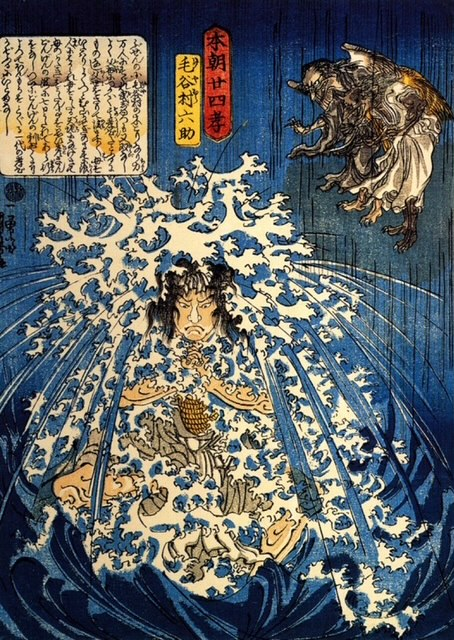

Shugendo, Shingon, Tendai,
Fall - Fortnight 19 (Earth+Wind)
![]() Feast/Dec
19: Japan. Shugendo, Tendai and Shingon
Sects. The taming of nature in the farm and garden and orchard. One straw
revolution. Korean natural farming. Swales, permaculture ponds. Mt Koyosan.
To explore ultimate reality thru ritual, mantra and mandala. Appreciation
of multi-culturalism and multi-religeous observance. (Japanese
Zen vs Chinese Chan.)
Feast/Dec
19: Japan. Shugendo, Tendai and Shingon
Sects. The taming of nature in the farm and garden and orchard. One straw
revolution. Korean natural farming. Swales, permaculture ponds. Mt Koyosan.
To explore ultimate reality thru ritual, mantra and mandala. Appreciation
of multi-culturalism and multi-religeous observance. (Japanese
Zen vs Chinese Chan.)
More evolved farming. 5 Food groups. Harvesting
and storing food. (Shugendo is a mix of Shinto, Tao, Buddhism) The
forest as mystery and Fudo. Hiking, seeking, exploring, pushing ones limits.
Food forests, foraging wild food vs cultivated farming. 75 Nabiki prayer
stations.
Enno Gyoja
Enno Gyoja (634–701 CE), founder of Shugendo, blended Shinto, Taoist, and Buddhist practices, centered at Kimpusenji and Hagurosan. Shingon malas and bamboo breathing tamed nature, reflecting Fuxi’s creation. His distinctive mountain asceticism explored ultimate reality through physical limits.
Saicho
Saicho (767–822 CE), founder of Tendai, introduced Chinese Tiantai to Japan, establishing Enryakuji with 33 worship sites. Shingon/Zen incense and forest bathing taught humanity, aligning with Fuxi’s fire gift. His unique multicultural synthesis via mantra and mandala enriched Japanese Buddhism.
Kukai
Kukai (774–835 CE), founder of Shingon, brought
esoteric Buddhism from China, founding Koyasan with Tozanha Shugendo. Shingon
womb and diamond banners instructed humanity, as Fuxi did, through ritual.
His distinctive mandalabased path revealed unity in diversity.
| Enno Gyoja/Shugendo 8thc CE (Kimpusen-ji & Haguro-san & Katsuragi Shugendo) | Saicho/Tendai 822 CE (Shozan-ha Shugendo) 33 Worship sites. | Kukai/Shingon d835 CE (Tozan-ha & Honzan-ha Shugendo) |
| Shingon malas and mantras, 5 Bamboo breathing | Shingon/Zen incense, shinto paper strips, forest bathing, Shugendo Nozoki rope over cliff | Shingon womb and diamond world banners, diamond sutra |
| Fuxi & Nuwa creates humanity | Fuxi teaches Humanity (Sui -Jen, brings fire) | Fuxi instructs Humanity |
4. Arriving within the Personal:
Within this rank, the Universal and Personal
beneficially interact, refining the attributes of the Personal. Each phenomenon’s
unique expression of the Universal is intimately perceived.
|
|
|
|
|
|
|
|
|
|
|
|
|
|
|
|
|
| RITE | - | - | - | - | - | - | - | - | - | - | - | - | - | - | - |
| PRACTICE | Niname sal Festival | 1. Liver Cleansing Breath - Breathing to cleanse and energize
the liver.
1. Wind Breathing - Breathing techniques to harmonize with
the wind.
|
2. Wood Qi Gathering - Drawing in wood element qi for vitality.
2. Wind Visualization - Meditating on wind to understand
impermanence.
|
3. Spring Visualization - Meditating on wood's growth and
renewal.
3. Flag Raising - Hoisting prayer flags to spread blessings with the wind. |
4. Wood Element Mantra - Chants to invoke wood's flexibility
and growth.
4. Sound of Wind Meditation - Listening to wind for peace and insight. |
5. Stretching Like Bamboo - Physical practices to emulate
wood's strength.
5. Wind Mantras - Chanting mantras associated with wind deities. |
6. Wood Cycle Meditation - Aligning with the wood element's
generative cycle.
6. Kite Flying - Using kites as a meditative practice linked to wind. |
7. Liver Qi Circulation - Ensuring smooth flow of liver
qi.
7. Wind Dance - Movements that mimic the flow and power of wind. |
8. Wood Energy Pathways - Following meridian paths associated
with wood.
8. Breath of the Wind - Pranayama focusing on the movement of air. |
9. Tree Rooting - Visualizing roots for stability and growth.
9. Sky Gazing - Observing the sky to feel the wind's omnipresence. |
10. Wood Transformation - Transforming negative emotions
into growth.
10. Tree Swaying - Standing like a tree, feeling the wind's sway for balance. |
11. Inner Tree Meditation - Seeing oneself as a tree for
wood essence connection.
11. Whistling Meditation - Using the whistle to connect with the wind's spirit. |
12. Wood Alchemy - Using wood energy for personal transformation.
12. Air Purification - Practices to cleanse oneself through breath and wind. |
Shugyo Fast | Shugyo Fast |
| STUDY | Shugendo | - | - | - | - | Tendai | - | - | - | - | Shingon | - | - | - | - |
| MEDITATION | - | - | - | - | - | - | - | - | - | - | - | - | - | - | - |
Group 4: Wood (Days 46–60)
Theme: Growth, flexibility, and nurturing the
Immortal Embryo (Neidan Stage 4: Nurturing the Embryo, Harmonizing Spirit).
Wood aligns with Shugendo’s forest asceticism and Zen’s natural metaphors.
Feast (Day 46): Prepare a Shojin Ryori meal with bamboo shoots and greens, honoring wood’s vitality.
Part 1: Jing (Essence) – Physical Practices
Focus: Physical actions connected to growth and
nature.
46. Forest Walking
Basis: Shugendo’s wandering
in forests; Zen’s nature as teacher.
Exercise: Walk slowly in a
forest (or visualize one), feeling each step connect you to the earth’s
pulse. Contemplate growth.
47. Tying Shinto Paper Rope
Basis: Shinto’s shimenawa
for sacred boundaries.
Exercise: Tie a small paper
rope (or string) around a tree or object, visualizing it as a boundary
for your sacred essence.
48. Sweeping Leaves
Basis: Zen’s mindful chores;
Dogen’s respect for nature.
Exercise: Sweep fallen leaves,
contemplating Dogen’s words: “A leaf falling is the whole universe.”
49. Planting a Seed
Basis: Chan/Zen farming; Neidan’s
nurturing of Jing.
Exercise: Plant a seed in
soil, visualizing it as your spiritual embryo, to be nurtured over time.
50. Using a Prayer Mala
Basis: Buddhist mala for mindfulness;
Shugendo’s ascetic tools.
Exercise: Run a mala through
your fingers, focusing on each bead as a step toward growth, visualizing
your essence expanding.
Part 2: Qi (Energy) – Mental Focus and Koans
Focus: Cultivating energy through wood-related
contemplation.
51. Koan: Dogen’s Cypress Tree
Basis: Zen koan: “What is
the sound of the cypress tree in the courtyard?”
Exercise: Sit in Zazen, contemplating
the cypress tree’s silence. Ask: “What is its voice?”
52. Breathing the Forest
Basis: Neidan’s circulation
of Qi; Shugendo’s forest energy.
Exercise: Inhale as if drawing
in forest air, exhale to release stagnation. Visualize Qi as green light
flowing through your limbs.
53. Chanting the Heart Sutra
Basis: Soto Zen’s use of the
Heart Sutra for insight.
Exercise: Chant “Gate Gate
Paragate Parasamgate Bodhi Svaha” softly, letting its rhythm align your
energy.
54. Koan: The Bamboo’s Bend
Basis: Zen’s metaphor of bamboo’s
flexibility.
Exercise: Contemplate: “How
does bamboo bend without breaking?” Let the question guide you to inner
resilience.
55. Contemplating Growth
Basis: Neidan’s nurturing
of the Immortal Embryo; Zen’s organic metaphors.
Exercise: Visualize a tree
growing within you, its roots in your Dantian, branches reaching your heart.
Contemplate: “I grow without effort.”
Part 3: Shen (Spirit) – Visualization and
Altar Work
Focus: Spiritual growth and connection to the
divine.
56. Wood Offering on Altar
Basis: Shugendo’s offerings
to forest spirits; Neidan’s symbolic growth.
Exercise: Place a small branch
or leaf on your altar. Meditate, visualizing your spirit as a tree reaching
for the heavens.
57. Visualizing the Immortal Embryo
Basis: Neidan’s nurturing
of the spiritual embryo.
Exercise: Sit, visualizing
a radiant child in your Dantian, growing stronger with each breath, symbolizing
your immortal self.
58. Forest Visualization
Basis: Shugendo’s forest meditation;
Zen’s nature as mirror.
Exercise: Visualize walking
through a forest, each tree a past life. At the center, find your true
self, radiant and eternal.
59. Offering to Forest Spirits (Fast Day)
Basis: Shugendo’s reverence
for kami; Neidan’s transcendence.
Exercise: Place a small offering
(rice or fruit) under a tree, dedicating it to forest spirits. Meditate
on life after death, visualizing yourself as a bodhisattva in nature.
60. Contemplating Impermanence (Fast Day)
Basis: Zen’s focus on transience;
Neidan’s preparation for immortality.
Exercise: Sit before your
altar, contemplating a fallen leaf. Visualize your body dissolving, yet
your spirit ascending as a bodhisattva.
---